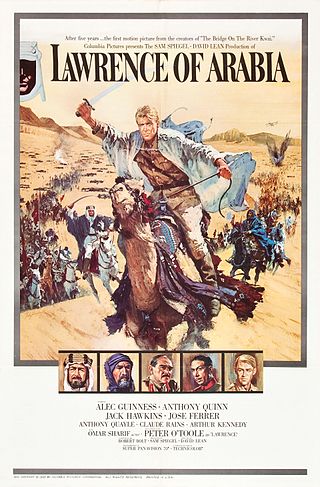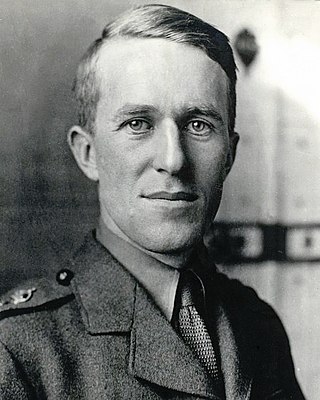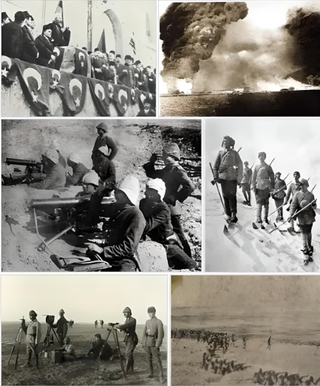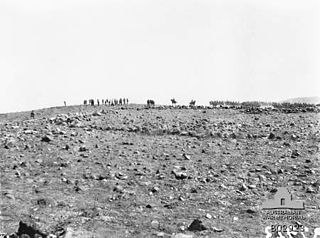Related Research Articles

Lawrence of Arabia is a 1962 epic biographical adventure drama film based on the life of T. E. Lawrence and his 1926 book Seven Pillars of Wisdom. It was directed by David Lean and produced by Sam Spiegel through his British company Horizon Pictures and distributed by Columbia Pictures. The film stars Peter O'Toole as Lawrence with Alec Guinness playing Prince Faisal. The film also stars Jack Hawkins, Anthony Quinn, Omar Sharif, Anthony Quayle, Claude Rains and Arthur Kennedy. The screenplay was written by Robert Bolt and Michael Wilson.

Thomas Edward Lawrence was a British archaeologist, army officer, diplomat, and writer who became renowned for his role in the Arab Revolt (1916–1918) and the Sinai and Palestine Campaign (1915–1918) against the Ottoman Empire during the First World War. The breadth and variety of his activities and associations, and his ability to describe them vividly in writing, earned him international fame as Lawrence of Arabia, a title used for the 1962 film based on his wartime activities.

Seven Pillars of Wisdom is the autobiographical account of the experiences of British Army Colonel T. E. Lawrence while serving as a military advisor to Bedouin forces during the Arab Revolt against the Ottoman Empire of 1916 to 1918.

The Arab Revolt or the Great Arab Revolt was an armed uprising by the Hashemite-led Arabs of the Hejaz against the Ottoman Empire amidst the Middle Eastern theatre of World War I.

The Battle of Megiddo was fought between 19 and 25 September 1918, on the Plain of Sharon, in front of Tulkarm, Tabsor and Arara in the Judean Hills as well as on the Esdralon Plain at Nazareth, Afulah, Beisan, Jenin and Samakh. Its name, which has been described as "perhaps misleading" since very limited fighting took place near Tel Megiddo, was chosen by British commander Edmund Allenby for its biblical and symbolic resonance.

Ahmed Djemal, also known as Djemal Pasha, was an Ottoman military leader and one of the Three Pashas that ruled the Ottoman Empire during World War I.

The Middle Eastern theatre of World War I saw action between 30 October 1914 and 30 October 1918. The combatants were, on one side, the Ottoman Empire, with some assistance from the other Central Powers; and on the other side, the British as well as troops from the British Dominions of Australia, Canada, and New Zealand, the Russians, and the French from among the Allied Powers. There were five main campaigns: the Sinai and Palestine, Mesopotamian, Caucasus, Persian, and Gallipoli campaigns.

The Battle of Aqaba was fought for the Red Sea port of Aqaba during the Arab Revolt of World War I. The attacking forces, led by Sherif Nasir and Auda abu Tayi and advised by T. E. Lawrence, were victorious over the Ottoman Empire defenders.

The Battle of Mecca occurred in the Muslim holy city of Mecca in June and July 1916. On June 10, the Sharif of Mecca, Hussein bin Ali, the leader of the Banu Hashim clan, started a revolt against the Ottoman Caliphate from this city. The Battle of Mecca was part of the Arab Revolt of World War I.

The Sharifian Army, also known as the Arab Army, or the Hejazi Army was the military force behind the Arab Revolt which was a part of the Middle Eastern theatre of World War I. Sharif Hussein Ibn Ali of the Kingdom of Hejaz, who was proclaimed "Sultan of the Arabs" in 1916, led the Sharifian Army in a rebellion against the Ottoman Empire with the ultimate goal of uniting the Arab people under an independent government. Aided both financially and militarily by the British, Husayn's forces gradually moved north through the Hejaz and, fought alongside the British-controlled Egyptian Expeditionary Force, eventually capturing Damascus. Once there, members of the Sharifian Army set up a short-lived monarchy known as the Arab Kingdom of Syria led by Faisal, a son of Sharif Husayn.
Lt Col. Stewart Francis Newcombe (1878–1956) was a British army officer and associate of T. E. Lawrence.

The Fourth Army of the Ottoman Empire was one of the field armies of the Ottoman Army. It was formed in the middle nineteenth century, during Ottoman military reforms.

The campaign in South Arabia during World War I was a minor struggle for control of the port city of Aden, an important way station for ships on their way from Asia to the Suez Canal. The British Empire declared war on the Ottoman Empire on 5 November 1914, and the Ottomans responded with their own declaration on 11 November. From the beginning, the Ottomans had planned an invasion of Britain's Aden Protectorate in cooperation with the local Arab tribes. The Ottomans had gathered in some strength on the Cheikh Saïd, a peninsula which juts out into the Red Sea towards the island of Perim.

The Capture of Damascus occurred on 1 October 1918 after the capture of Haifa and the victory at the Battle of Samakh which opened the way for the pursuit north from the Sea of Galilee and the Third Transjordan attack which opened the way to Deraa and the inland pursuit, after the decisive Egyptian Expeditionary Force (EEF) victory at the Battle of Megiddo during the Sinai and Palestine Campaign of World War I. Damascus was captured when Desert Mounted Corps and Prince Feisal's Sherifial Hejaz Army encircled the city, after a cavalry pursuit northwards along the two main roads to Damascus. During the pursuit to Damascus, many rearguards established by remnants of the Ottoman Fourth, Seventh and Eighth Armies were attacked and captured by Prince Feisal's Sherifial Army, Desert Mounted Corps' Australian Mounted Division the 4th and the 5th Cavalry Divisions. The important tactical success of capturing Damascus resulted in political manoeuvring by representatives from France, Britain and Prince Feisal's force.
The Capture of Yanbu was an Ottoman attempt to recapture the city of Yanbu during the Arab Revolt.
The Battle of Wadi Musa was fought between the Arab Army and the Ottoman Empire during the Arab Revolt of 1916–1918.

The Charge at Kaukab took place on 30 September 1918 about 10 miles (16 km) south of Damascus during the pursuit by Desert Mounted Corps following the decisive Egyptian Expeditionary Force victory at the Battle of Megiddo and the Battle of Jisr Benat Yakub during the Sinai and Palestine Campaign of World War I. As the Australian Mounted Division rode along the main road north, which connects the Galilee with Damascus via Quneitra, units of the division charged a Turkish rearguard position located across the main road on the ridge at Kaukab.
Tafas is a town in southern Syria, administratively part of the Daraa Governorate, located north of Daraa. Nearby localities include al-Shaykh Saad and Nawa to the north, Da'el, Abtaa and al-Shaykh Maskin to the northeast, Saham al-Jawlan and Adwan to the northwest and Muzayrib to the southwest. According to the Syria Central Bureau of Statistics, Tafas had a population of 32,236 in the 2004 census.
The Charge at Kiswe took place on 30 September 1918 about 9 miles (14 km) south of Damascus, during the pursuit by Desert Mounted Corps following the decisive Egyptian Expeditionary Force victory at the Battle of Megiddo, the Battle of Jisr Benat Yakub and the Charge at Kaukab during the Sinai and Palestine Campaign in World War I. As Desert Mounted Corps rode along the main road from Nablus, units of the 14th Cavalry Brigade, 5th Cavalry Division, were ordered to charge a rearguard north of Kiswe, protecting columns of the Ottoman Fourth Army, retreating towards Damascus.

The Charge at Khan Ayash occurred on 2 October 1918 about 17 miles (27 km) north of Damascus after the pursuit to, and capture of Damascus, which followed the decisive Egyptian Expeditionary Force victory at the Battle of Megiddo on 25 September during the Sinai and Palestine Campaign of World War I. After Damascus had been encircled by Desert Mounted Corps on 30 September, the 3rd Light Horse Brigade advanced through the city on 1 October to charge and capture remnants of the Ottoman Yildirim Army Group withdrawing along the road north to Rayak and Homs.
References
- ↑ "A Prince of Our Disorder". Google books. Retrieved 23 August 2014.
- 1 2 3 4 Lowell, Thomas (1924). With Lawrence in Arabia. Grosset & Bunlap. pp. 209–211.
- ↑ Murphy, 2011, p. 44.
- ↑ "Lawrence of Arabia, 1918". eyewitnesstohistory.com. Retrieved 22 August 2014.
- ↑ Lawrence, Thomas Edward (1939). Seven Pillars of Wisdom. The Reprint Society. p. 652.